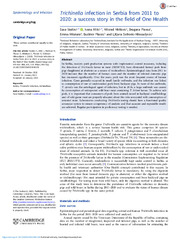Приказ основних података о документу
Trichinella infection in Serbia from 2011 to 2020: a success story in the field of One Health
| dc.creator | Vasilev, Saša | |
| dc.creator | Mitić, Ivana | |
| dc.creator | Mirilović, Milorad | |
| dc.creator | Plavša, Dragana | |
| dc.creator | Milakara, Emina | |
| dc.creator | Plavšić, Budimir | |
| dc.creator | Sofronić-Milosavljević, Ljiljana | |
| dc.date.accessioned | 2023-02-14T10:22:38Z | |
| dc.date.available | 2023-02-14T10:22:38Z | |
| dc.date.issued | 2023 | |
| dc.identifier.issn | 0950-2688 | |
| dc.identifier.uri | https://vet-erinar.vet.bg.ac.rs/handle/123456789/2541 | |
| dc.description.abstract | In Serbia, modern pork production systems with implemented control measures, including the detection of Trichinella larvae in meat (ISO18743), have eliminated farmed pork from pigs slaughtered at abattoirs as a source of trichinellosis. Epidemiological data from 2011 to 2020 indicate that the number of human cases and the number of infected domestic pigs has decreased significantly. Over the years, pork was the most frequent source of human infection. Cases generally occurred in small family outbreaks, and the infection was linked to consumption of raw or undercooked pork from backyard pigs. In most of the outbreaks, T. spiralis was the aetiological agent of infection, but in 2016, a large outbreak was caused by consumption of uninspected wild boar meat containing T. britovi larvae. To achieve safe pork, it is important that consumers of pork from animals raised in backyard smallholdings and of wild game meat are properly educated about the risks associated with consumption of untested meat. Laboratories conducting Trichinella testing should have a functional quality assurance system to ensure competency of analysts and that accurate and repeatable results are achieved. Regular participation in proficiency testing is needed. | sr |
| dc.language.iso | en | sr |
| dc.publisher | Cambridge University Press | sr |
| dc.relation | info:eu-repo/grantAgreement/MESTD/inst-2020/200019/RS// | sr |
| dc.rights | openAccess | sr |
| dc.rights.uri | https://creativecommons.org/licenses/by/4.0/ | |
| dc.source | Epidemiology and Infection | sr |
| dc.subject | Serbia | sr |
| dc.subject | Trichinella infection | sr |
| dc.subject | trichinellosis | sr |
| dc.title | Trichinella infection in Serbia from 2011 to 2020: a success story in the field of One Health | sr |
| dc.type | article | sr |
| dc.rights.license | BY | sr |
| dc.citation.volume | 151 | |
| dc.citation.volume | 8 | |
| dc.citation.spage | 20e | |
| dc.identifier.doi | 10.1017/S0950268823000109 | |
| dc.identifier.fulltext | http://veterinar.vet.bg.ac.rs/bitstream/id/7349/bitstream_7349.pdf | |
| dc.type.version | publishedVersion | sr |

